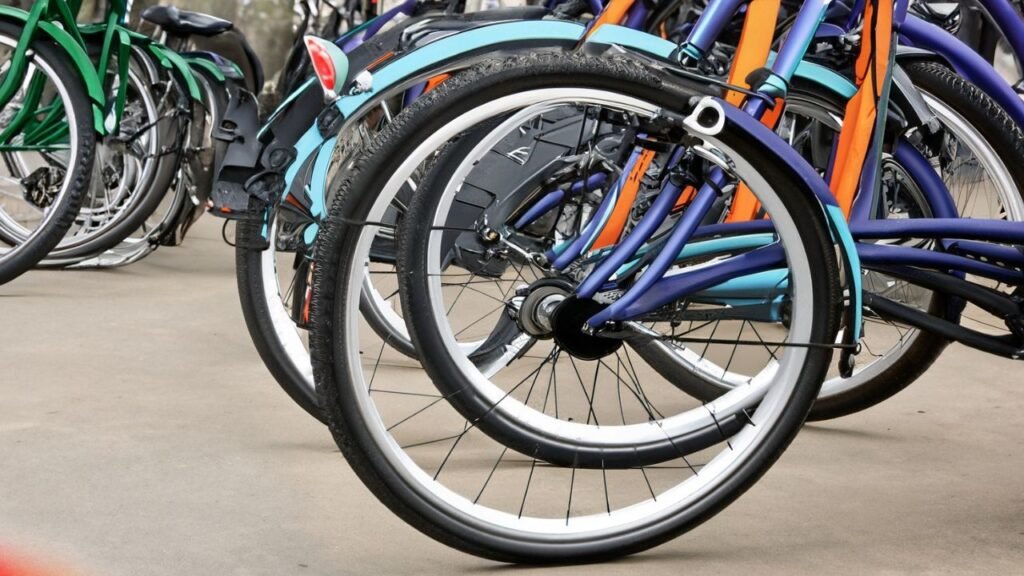Bike fenders are essential accessory for bikers this providing protection from splashes, debris and wet conditions. They are designed to be attached to the front & rear wheels of bike effectively shielding both the rider and bike components from potential damage. In this article we will talk about What are Fenders On A Bike, discussing their types, materials, importance, installation process, maintenance and more.

Table of Contents
What are Bike Fenders?
Bike fenders also known as mudguards are devices that are mounted on a bicycle to prevent water dirt and other debris from being thrown up by the rotating wheels. By creating a barrier between the tires and the rider fenders help keep both the cyclist and the bike cleaner and more protected.
There are two main types of bike fenders: full fenders and clip on fenders. Full fenders as the name suggests provide complete coverage for the wheels offering optimal protection from splashes and debris. These are made of plastic or metal and are attached to the frame and bike fork. On the other hand clip on fenders are removable and can be easily attached or detached when needed. They are best suited for bikes without fenders and eyelets and are usually made of lightweight plastic.

Why Are Bike Fenders Essential?
Bike fenders play important role in ensuring a comfortable & clean biking experience. They offer several benefits including:
- Protection from splashes and debris: When riding on wet or muddy surfaces the rotating wheels can kick up water, mud, rocks and other debris. Bike fenders act as a shield preventing these elements from hitting the riders body, clothes and face.
- Keeps you dry in wet conditions: Riding in the rain can be unavoidable at times but with the proper bike fenders you can stay relatively dry. They reduce the amount of water sprayed onto you providing a more enjoyable and comfortable ride.
- Protects your bike components: Water, dirt and grime can find their way into bike parts such as the chain, gearbox and brakes, causing premature damage. Fenders help increase likelihood of these things happening & extend your bike life.

Also Read: Why are Bike Saddles so Uncomfortable: Unraveling the Secrets
How Bike Fenders Are Work?
Installing bike fenders requires some manual work but the benefits they provide make it worthwhile. The installation process may vary depending on the type of fender but here is a general overview:
- Attaching full fenders: Full fenders are typically mounted using attachment points located on the frame and fork of the bike. These attachment points known as fender eyelets allow for secure and stable installation. The fenders are positioned to ensure proper coverage and clearance from the tires.
- Mounting clip on fenders: The clips on the fenders are designed for bikes without fender eyes. They usually come with adjustable brackets or straps that can be attached to the bike frame or seat post. The fenders can be adjusted to achieve the desired coverage and position.
When properly installed bike fenders extend beyond the edges of the wheels creating a barrier between the tires and the surrounding environment. The fender length and width plays important role in determining their coverage & effectiveness.
Choosing the Right Bike Fenders
Selecting the appropriate bike fenders for your specific needs is essential. Here are several factors to consider:
- Matching fenders to your bike: Ensure that your bike fenders you choose are compatible with your bike wheel size & frame design. Different bikes have require different styles fenders.
- Considering tire size: The width of your bike tires will determine the width of the fenders needed. It is crucial to choose fenders wide enough to provide adequate coverage and prevent splashes from escaping.
- Weight and durability: Consider the material used for the fenders. Plastic fenders are lightweight and affordable while metal fenders offer enhanced durability and robustness.
Bike Fenders Installation
To install bike fenders you will need some basic tools such as a screwdriver, wrench & possibly some zip ties. Here are 5 steps to help you complete installation process:
- Preparation: Gather some necessary tools & you sure that have the correct fenders for your bike. Read the manufacturer instructions before starting.
- Front fender installation: Attach the front fender to the fork using fender eyelets or adjustable brackets depending on the type of fender. Adjust the position and secure it tightly.
- Rear fender installation: Mount the rear fender to the frame using fender eyelets or brackets. Ensure that it provides adequate coverage and is properly aligned with the rear wheel. Secure it in place.
- Check for clearance: Rotate the wheels to ensure that the fenders do not rub against the tires or any other bike components. Make adjustments if necessary.
- Test ride: Take your bike for a short test ride to confirm that the fenders are properly installed and functioning as intended.
Maintaining Your Bike Fenders
Proper maintenance of bike fenders can significantly extend their lifespan. Consider the following tips:
- Preventing rust and corrosion: Metal fenders are prone to rust and corrosion especially in wet conditions. To keep them in good shape, coat or paint them with rust-resistant paint.
- Cleaning and maintenance tips: Regularly clean your fenders to remove dirt and grime using mild soap and water. Not using any abrasive cleaners that may surface damage. Check for any loose fittings and tighten them if necessary.
FAQs: About What are Fenders On A Bike
Q1. Are Bike fenders essential for bikes?
A: Bike fenders are particularly useful for commuters, road cyclists and mountain bikers who ride in wet or muddy conditions. However they are not essential for every bike especially those used primarily in dry environments.
Q2. Can I install bike fenders on a bike without eyelets or brackets?
A: Yes you can still attach clip-on fenders to bikes without fender eyelets or brackets. These fenders usually come with adjustable straps or brackets that can be mounted on the bike frame or seat post.
Q3. Are bike fenders affect the bikes aerodynamics?
A: While bike fenders may slightly affect the aerodynamics of the bike the impact is often negligible. The benefits of protection and comfort outweigh the minimal decrease in aerodynamic efficiency.
Q4. How often should I clean my bike fenders?
A: Regular cleaning of bike fenders is recommended especially after riding in wet or muddy conditions. Check for accumulated dirt and debris and clean them as often as necessary to maintain their effectiveness.
Q5. Can I use one set of bike fenders for multiple bikes?
A: In general bike fenders are designed to be compatible with specific wheel sizes and frame types. It is recommended to use the appropriate fenders for each bike to ensure optimal fit and coverage.
Conclusion: What are Fenders On A Bike
Bike fenders are important accessories this protect riders & bikes from splashes, debris & wet conditions. They have available in different types of materials with also offering unique features and benefits. Installing bike fenders ensures a cleaner, drier & safer cycling experience. With proper maintenance they can use for a long time.

